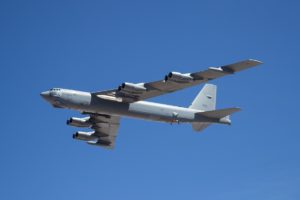
The commander of Air Force Materiel Command (AFMC) said on July 1 that AFMC’s hypersonic development efforts are proceeding as a high priority effort despite the operational hurdles of the COVID-19 environment.
“As we went into COVID, we started prioritizing missions that we needed to keep on track to move out and keep going because there were some things based on the limited numbers I could bring into some of the facilities for test, some of the things that we’ve been limited to in the research world and what we were doing,” AFMC Commander Gen. Arnold Bunch said in response to a question during a Mitchell Institute for Aerospace Studies’ Aerospace Nation virtual discussion. “There were certain areas that got a higher priority, and we moved forward. That [hypersonics] was high enough priority that we were continuing to do work at Arnold [AFB, Tenn.], at Holloman [AFB, N.M.], at Eglin [AFB, Fla.] and at Edwards [AFB, Calif.] to keep it all moving forward.”
Last spring, the Air Force released a solicitation for its next hypersonic platform, a scramjet cruise missile (Defense Daily, April 29). In 2018, the service contracted Lockheed Martin [LMT] as the lead for the AGM-183A Air-Launched Rapid Response Weapon (ARRW), which would be a boost-glide standoff weapon. In February, it canceled the concurrent Hypersonic Conventional Strike Weapon (HCSW) program to focus entirely on ARRW’s progress (Defense Daily, Feb. 10).
“Hypersonics efforts are high priority, and we’re really moving out,” Bunch said on July 1. “All of those are progressing. ARRW right now, I would say, is our leading candidate. We started HCSW and ARRW dual path. The intent all along was that if ARRW proceeded normally, there would be a time we would go off of HCSW because of budget constraints, and we have done that because ARRW is proceeding accordingly and doing very well.”
“All of the efforts are progressing, and I’m not seeing any issues with the integration schedules that we had,” Bunch said.
The Air Force has worked with industry, military installations and local communities to sustain hypersonics development, he said.
The 2018 National Defense Strategy mentions hypersonics development as key in facing strategic competitors, like China and Russia, and other adversaries, such as North Korea and Iran. The Pentagon has said that hypersonic weapons, those with speeds above Mach 5, will be highly maneuverable, operate at varying altitudes, and be able to strike high-value targets thousands of miles away in minutes. In addition, the Missile Defense Agency (MDA) is eyeing hypersonics.
The top speed of AGM-183A is advertised as Mach 20.
In June last year, the Air Force conducted its first flight test of a prototype AGM-183A on a Boeing [BA] B-52H bomber at Edwards AFB. Integration efforts on the Boeing B-1B bomber may also be under consideration, and industry is looking at the integration of a 7,000-pound AGM-183A on the center line of a Boeing F-15EX fighter.
Pacific Air Forces Commander Gen. Charles Brown, who is to assume the position of Air Force Chief of Staff on Aug. 6, told the Senate Armed Services Committee in May that he views hypersonics as a top development area for the Air Force in concert with industry and academia. Brown told lawmakers that he observes China’s hypersonic advancements on a day-to-day basis with access to intel reports and open-source information, and the Defense Department must move more quickly to ensure its hypersonic weapons are fielded in time.
During a July 1 discussion on the current state of the Air Force, Air Force Chief of Staff David Goldfein told a Brookings Institution virtual audience that sound digital engineering will underlie hypersonics and other planned DoD leap ahead technologies.
“What industry has learned and that we have got to follow is that you can’t skip the step of digital engineering and data architecture,” he said. “When somebody comes over here and throws out the game changers of artificial intelligence, hypersonics, directed energy, [and] quantum [computing], they ask the next important question. Exactly what data are you planning on accessing to do artificial intelligence, and how are you going to get that? Let’s talk about hypersonics. How are you going to find, fix, and then finish with a long-range hypersonic weapon? How are you going to get mid-course guidance against a moving target?”
Mark Lewis, DoD’s Director of Defense Research and Engineering for Modernization, called hypersonics “essential” during a June 30 Hudson Institute virtual event. “Speed is the new stealth,” Lewis said, as he suggested a hypersonic weapons mix of boost-glide and air breathing systems as a “high-low” mix, boost glide for long-range missions requiring more maneuverability, and air breathing scramjet hypersonic weapons for short and medium ranges.
The long-range boost glide would likely be more expensive and thus fielded in smaller numbers, while $2 million unit costs for tactical hypersonic weapons “could make these affordable, compared to current precision weapons,” according to Byron Callan, a defense analyst with Capital Alpha Partners.